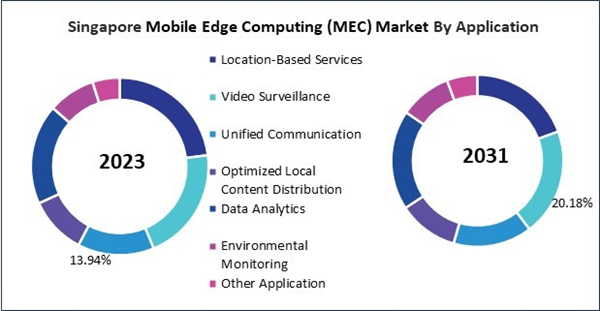The China market dominated the Asia Pacific Mobile Edge Computing (MEC) Market by country in 2023, and is expected to continue to be a dominant market till 2031; thereby, achieving a market value of $553.7 million by 2031. The Japan market is registering a CAGR of 32.4% during 2024-2031. Additionally, the India market would capture a CAGR of 34% during 2024-2031.
MEC’s role in IoT extends to both advanced industrial and consumer applications. MEC supports real-time decision-making in industries such as predictive maintenance in smart factories or traffic management in smart cities, improving operational efficiency and safety. For consumers, MEC ensures that devices like voice assistants and smart thermostats deliver instantaneous responses while enhancing data privacy by keeping sensitive information local. By enabling IoT devices to operate effectively even in bandwidth-constrained or remote environments, MEC not only meets the demands of today’s interconnected world but also unlocks the full potential of IoT, driving innovation and creating opportunities for economic growth.
The significant increase in mobile data traffic, propelled by streaming services, online entertainment, and remote work, has exerted considerable strain on conventional network infrastructure. MEC addresses this challenge by processing data locally, reducing congestion, and ensuring faster delivery. For example, streaming platforms like Netflix and YouTube benefit from MEC’s ability to cache frequently accessed content at the network edge, enabling seamless high-definition (HD) and 4K streaming without overloading central servers. Similarly, online gaming platforms, particularly cloud-based services like Google Stadia and NVIDIA GeForce Now, rely on MEC to deliver graphically intensive games with minimal latency, providing smooth and responsive gameplay for users.
In Australia, the market is expanding across multiple industries, driven by the government’s significant investments in digital infrastructure and support for remote work solutions. The Australian IT and IT-enabled services (ITeS) sector is flourishing, with the digital economy projected to contribute AUD 250 billion to GDP by 2030, as the Australian Trade and Investment Commission reported. MEC is integral to this growth, providing localized computing power that supports remote work, smart infrastructure, and innovative digital services critical to the country’s evolving economic landscape. As a result, Asia Pacific is becoming a global powerhouse in the mobile edge computing (MEC) market, driving advancements across industries and solidifying its position as a leader in edge technologies.
List of Key Companies Profiled
- Nokia Corporation
- Huawei Technologies Co., Ltd. (Huawei Investment & Holding Co., Ltd.)
- Ericsson AB
- IBM Corporation
- Microsoft Corporation
- Cisco Systems, Inc.
- Dell Technologies, Inc.
- Hewlett Packard Enterprise Company
- Amazon Web Services, Inc. (Amazon.com, Inc.)
- Intel Corporation
Market Report Segmentation
By Enterprise Size- Large Enterprises
- Small & Medium-sized Enterprises (SMEs)
- Hardware
- Software
- Services
- Location-Based Services
- Video Surveillance
- Unified Communication
- Optimized Local Content Distribution
- Data Analytics
- Environmental Monitoring
- Other Application
- China
- Japan
- India
- South Korea
- Singapore
- Malaysia
- Rest of Asia Pacific
Table of Contents
Companies Mentioned
- Nokia Corporation
- Huawei Technologies Co., Ltd. (Huawei Investment & Holding Co., Ltd.)
- Ericsson AB
- IBM Corporation
- Microsoft Corporation
- Cisco Systems, Inc.
- Dell Technologies, Inc.
- Hewlett Packard Enterprise Company
- Amazon Web Services, Inc. (Amazon.com, Inc.)
- Intel Corporation
Methodology

LOADING...









